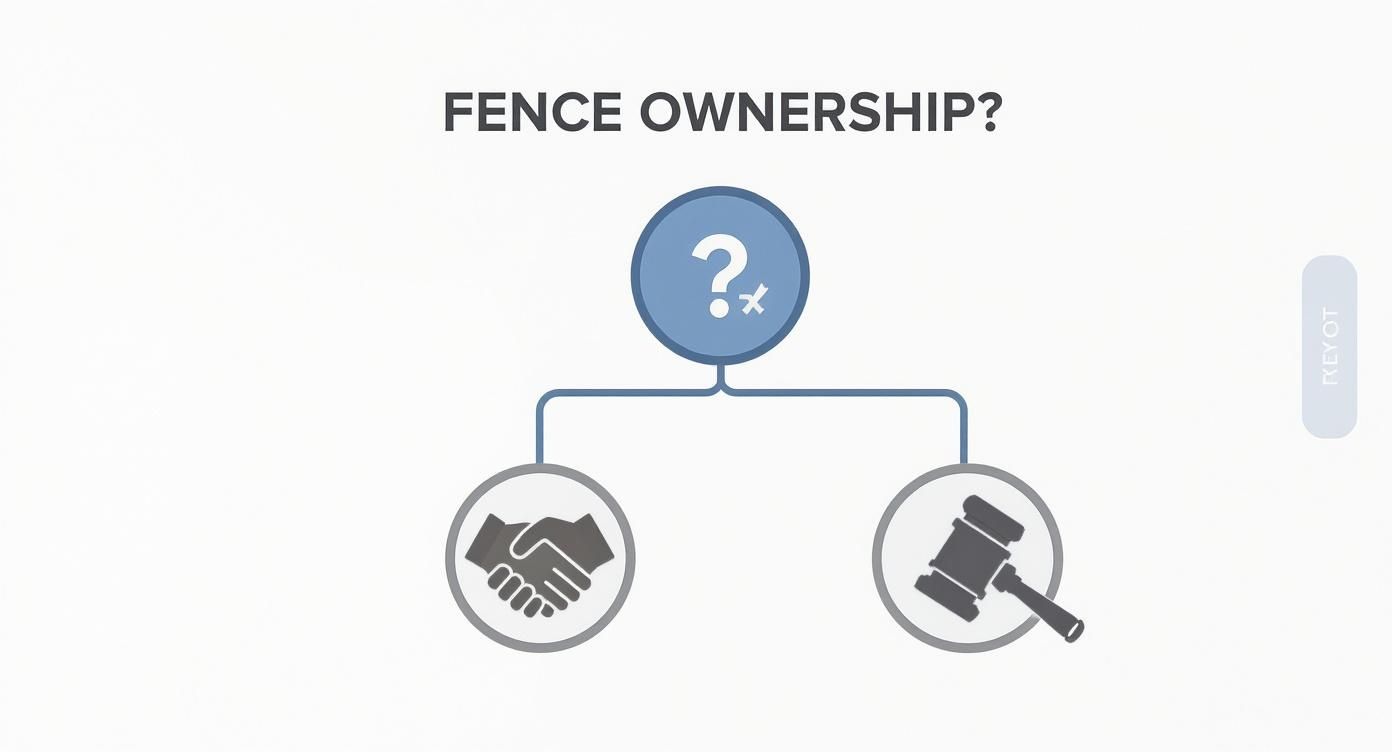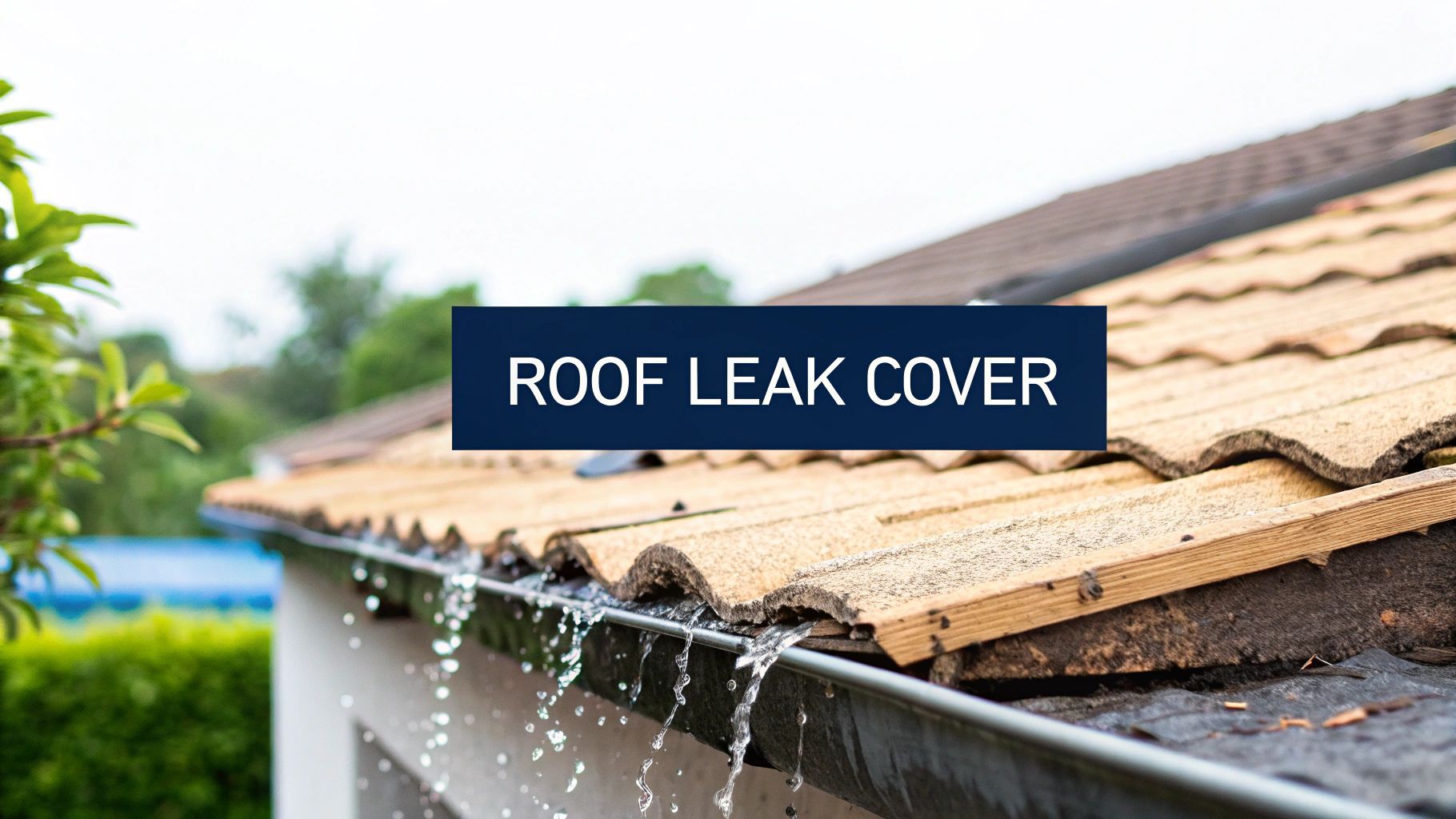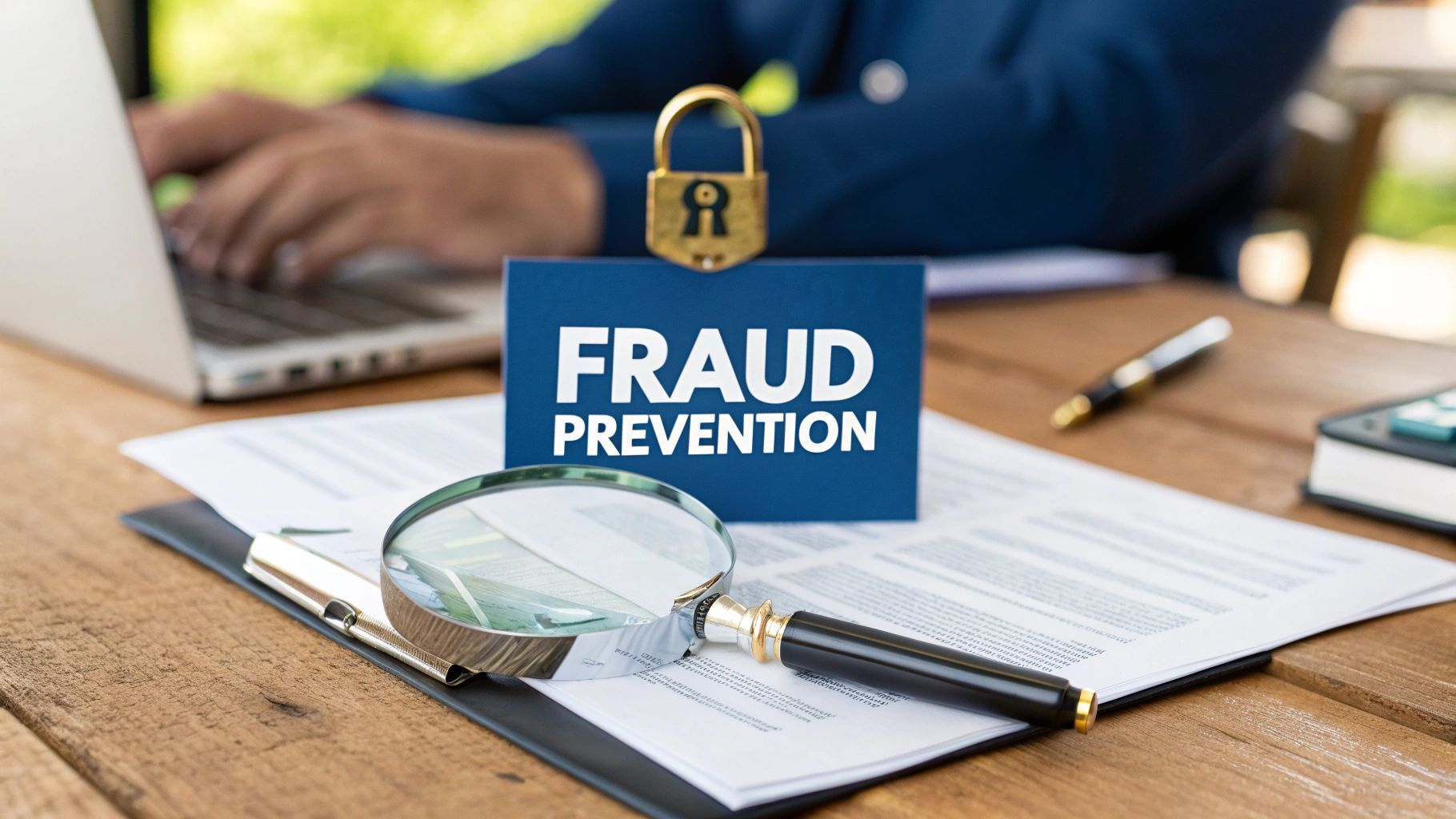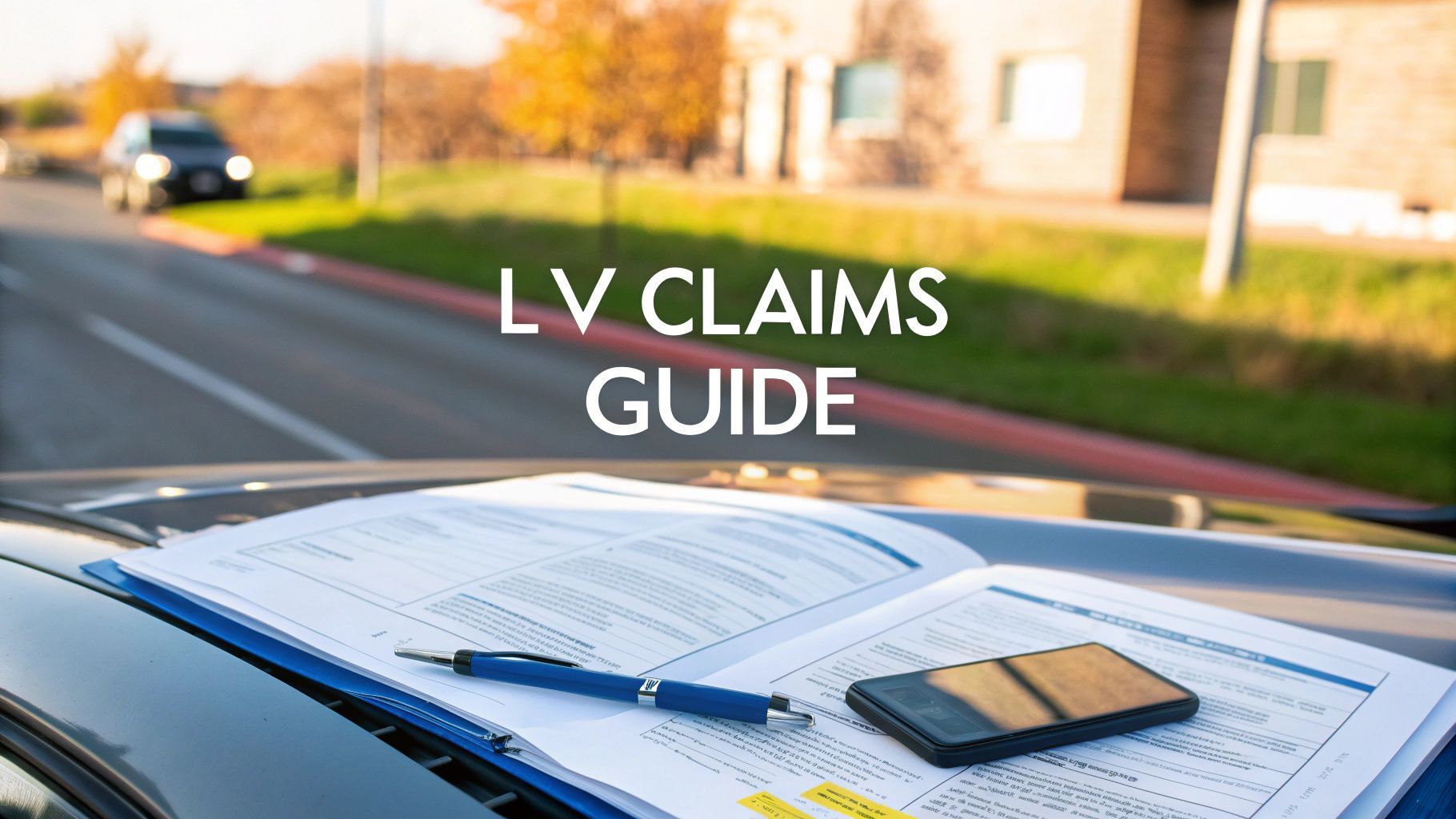How to Tell Which Fence Is Yours in the UK
Knowing which fence is yours can feel like a bit of a mystery. It is one of those things you do not think about until a storm brings a panel down or your neighbour mentions building an extension. Suddenly a simple question of ownership becomes urgent.
This ambiguity is a classic source of friction between neighbours, often spiralling into stressful and expensive disagreements. The key is not a quick glance or an old wives' tale but finding provable evidence in your property deeds.
The Problem with "Common Knowledge"
One of the most persistent myths out there is the "left-hand rule", the idea that you are always responsible for the fence on your left. Let us be clear: this is not a legal principle in the UK. You should never, ever assume it is true. Ownership is spelled out in legal documents, not determined by convention.
Relying on these kinds of assumptions is where the real trouble starts.
The Real Cost of Getting It Wrong
The consequences of a wrong guess can go far beyond an awkward chat over the garden wall. People often end up paying to repair or replace a fence that was never their responsibility in the first place.
Even more seriously, if you try to claim on your insurance for damage to a fence you do not legally own, it can be flagged as potential fraud. That does not just mean your claim gets rejected but it contributes to rising premiums for everyone. The insurance industry loses a staggering amount to fraudulent claims and those costs are ultimately passed on to honest policyholders.
These disputes are far more common than you might think. Our research found that nearly a fifth of UK homeowners ( 23% ) have been dragged into a property boundary disagreement. That is around 11 million people affected by these stressful issues. You can dig into the full research on boundary disputes to see the true scale of the problem.
This is why establishing clear, provable ownership is so important. It is not just about keeping the peace with your neighbours—it is about financial common sense. Having a clear record of your assets before an issue arises is invaluable. It provides the solid proof you need to make any future insurance claims legitimate and hassle-free, protecting you from significant financial and legal risk.
When you are trying to figure out which fence is yours, assumptions are your worst enemy. The only real truth is tucked away in your property’s legal documents. These records, held by HM Land Registry , are the only place to start if you want provable ownership and want to avoid a costly, stressful dispute with your neighbour.
Relying on old conventions or guesswork can cause serious headaches. Imagine you repair or replace a fence that is not legally your responsibility and then try to claim for the damage. You would likely have the claim denied. Worst-case scenario? It could even be flagged as potential insurance fraud, a serious issue that contributes to higher premiums for everyone. Getting it right from the start protects your wallet and keeps the claims process fair.
Understanding Your Title Plan
Your first port of call is to get a copy of your title plan and register. You can request these directly from the HM Land Registry website for a small fee. Once you have them in hand, you are looking for specific symbols that spell out boundary responsibilities.
The most important symbol to look for is a ‘T’ mark . If you see a 'T' marked on a boundary line on your plan and its stem points into your property, that is a clear indicator that the boundary is your responsibility. If you see an ‘H’ mark (which looks like two ‘T’s joined together), this signifies a party wall or fence where responsibility is shared between you and your neighbour.
This infographic breaks down the process in a simple, visual way.

As you can see, having clear proof from your documents almost always leads to a straightforward agreement. It is the ambiguity that causes problems.
While you are looking at the documents, do not just scan for symbols. Read the property register carefully for any specific notes or covenants . These are legally binding rules that can include explicit details about fence maintenance obligations, often passed down from previous owners. This kind of written evidence is your strongest asset, giving you a factual foundation that removes all doubt before you even think about approaching a neighbour or filing an insurance claim.
Decoding Boundary Symbols on Your Title Plan
Your title plan might seem a bit cryptic at first glance but understanding a few key symbols can clear things up quickly. These marks are the official language of property boundaries.
Here is a quick reference table to help you make sense of what you are looking at.
| Symbol | What It Means | What You Should Do |
|---|---|---|
| A 'T' mark | The stem of the 'T' points towards the property responsible for maintaining that boundary. | If the 'T' points to your property, the fence is yours. If it points to your neighbour's, it is theirs. |
| An 'H' mark | This is essentially two 'T' marks joined together, indicating a shared boundary or "party wall". | Responsibility and costs for maintenance are shared equally between you and your neighbour. |
| A solid black line | This simply shows the general position of a physical boundary feature like a fence, wall, or hedge. | This line alone does not indicate ownership. You need to look for other symbols or notes in the register. |
| No symbols at all | The plan shows the boundary exists but responsibility has not been legally defined in the deeds. | This is a grey area. Ownership may be based on assumptions or informal agreements, which can lead to disputes. |
Remember, these symbols provide the best legal evidence available. If your plan is clear, you are in a strong position. If it is ambiguous, it might be time to gather more information.
Getting Your Hands Dirty: Clues from a Physical Fence Inspection
While your property deeds are the official word on ownership, the fence itself tells a story. A good old-fashioned physical inspection can reveal a history of maintenance and construction that often lines up with what the paperwork says. This is not just a quick glance over the garden wall but about looking for practical, real-world clues.
A great place to start is the old 'good side, bad side' rule. Traditionally, whoever puts up a fence gives their neighbour the smooth, finished side to look at. This leaves the posts and rails—the 'bad side'—on their own property. Now, this is not a legally binding rule by any means but it is a long-standing convention. If your deeds are a bit vague, it can be a strong hint about who originally installed it.

Uncovering the History of Maintenance
Next, play detective and look for signs of upkeep or neglect. Consistent repairs, a few mismatched panels or even updated components like modern galvanised fence posts on one side can point to who has been taking care of the fence over the years.
Make sure you document everything you find. Whip out your phone, take clear photos and jot down detailed notes. This visual record can be incredibly useful down the line. Here is what to keep an eye out for during your inspection:
- Age and Condition: Do some sections look newer than others? This could suggest a phased replacement over time.
- Repair Work: Can you spot any evidence of patches, new screws or a recent lick of paint that points to one household’s handiwork?
- Consistency: Does the fence's style match the other boundaries on your property or does it look more like your neighbour's setup?
By methodically gathering this physical evidence, you are moving beyond just guesswork. You are actually building a practical case that complements your legal documents, which is crucial if you ever need to make an insurance claim. Proving a consistent history of maintenance is a key part of demonstrating ownership.
This kind of thorough documentation not only puts you in a stronger position for a friendly chat with your neighbour but also gives you the provable evidence that insurers often require. When the deeds are giving you nothing and a friendly chat with your neighbour has gone nowhere, it is probably time to call in an expert.
Bringing in a chartered surveyor is the surest way to get a definitive answer on who owns which fence, ending the guesswork for good. This is the step that shifts the conversation from opinion to fact.
A professional surveyor brings an impartial eye to the situation, relying purely on evidence. They do more than just glance at your title plan; they will conduct a detailed site survey and even dig into historical documents to pinpoint the precise legal boundary. It is a process designed to take the emotion and guesswork right out of the equation.

The Surveyor’s Report as Legal Proof
The final report you get from a surveyor is not just their professional take—it is a legally recognised document. In the UK, chartered surveyors are the official route for resolving these kinds of disputes. They meticulously analyse deeds, old maps and on-site data to define where one property ends and another begins, a process outlined on the official UK government property boundaries guide.
This formal report is your proof of ownership, plain and simple. You can use it to update your records with HM Land Registry, creating an official and permanent clarification of your responsibilities. This is not just about solving today's problem but about preventing any more from cropping up down the line.
Having this official documentation is invaluable when it comes to insurance. It provides the verifiable evidence needed to support a claim for damage, protecting you from rejection or accusations of fraud. Without it, you are leaving your claim open to interpretation, which can be a costly risk.
An Alternative to Court
Hiring a surveyor does not mean you are automatically heading for a court battle. In fact, it often does the opposite. Their clear, evidence-based findings can present an indisputable conclusion that stops legal action in its tracks.
For trickier situations, services like the RICS Boundary Disputes Mediation Service offer a pragmatic, less confrontational path forward. It is designed to help you and your neighbour reach a formal agreement without the immense stress and expense of going to court.
How to Talk to Your Neighbour About the Fence
Getting to a friendly agreement is always the best possible outcome. But before you even think about knocking on their door, get your paperwork in order. Gather up your property deeds, the survey and any photos you took during your initial check.
Walking over with this evidence helps keep the conversation grounded in facts, not just feelings.
It is all about the approach. Instead of opening with a confrontational, “We need to talk about the fence ,” try something more collaborative. A simple, “I was just looking at the garden fence and was wondering if you had any idea whose responsibility it is?” opens the door for a discussion, not a dispute.
Keeping the Conversation Productive
The whole point here is to find a workable solution, not to win an argument. A calm, evidence-based chat is your best bet for preventing the whole thing from spiralling into a stressful and expensive legal mess.
- Bring Your Documents: Having your title plan with you shows you have done your homework and are serious about figuring this out based on facts.
- Suggest a Party Fence Agreement: If it turns out the ownership is genuinely shared or unclear, you could propose a formal agreement to split the responsibility moving forward. It is a great way to avoid future confusion.
- Hear Them Out: Your neighbour might have documents or information you have never seen. Give them the space to share their side of the story; you might learn something that solves the problem right there and then.
Avoiding a formal dispute is absolutely critical. These disagreements can take a massive toll. In fact, research shows that British homeowners often spend 6 to 12 months stuck in boundary battles before they reach any kind of resolution. You can read more about the impact of these great British boundary battles to see just how messy they can get.
An informal agreement over a cup of tea is infinitely better than a formal one through solicitors. A good relationship with your neighbour is a valuable asset and a small fence issue should not be what destroys it. The cost of a dispute will always far outweigh the cost of a new fence panel.
Ultimately, getting this sorted now prevents future misunderstandings and protects both of you from the financial and emotional drain of a long-running argument. A simple, friendly conversation is the most powerful first step you can take.
Common Questions About Fence Ownership Answered
Even with your deeds in hand, some situations can still leave you scratching your head. Let us walk through a few of the most common curveballs that homeowners face when trying to figure out which fence is theirs.
Getting this right is not just about avoiding a dispute; it can save you from paying for work that is not your responsibility.
What if My Deeds Have No T-Marks?
Finding no 'T' marks on your title plan is more common than you might think. When this happens, there is no legal presumption of ownership for any particular boundary. The fence is often considered a 'party fence', meaning the responsibility is shared equally between you and your neighbour.
This is actually a great opportunity to get proactive. You can chat with your neighbour about creating a formal boundary agreement. Putting something down in writing about shared responsibility is a brilliant way to prevent disagreements down the line, especially when repairs inevitably pop up.
Does the Good Side Rule Have Legal Standing?
We have all heard it: the person who has the 'ugly' side of the fence (with the posts and rails) owns it and the 'good' side faces the neighbour. While this is a long-standing convention in the building trade, it has no legal weight in the UK .
Think of it as a helpful clue but never the deciding factor. Your property deeds and official surveys will always trump this custom. Do not ever rely on it as your only piece of proof because it simply will not stand up in a formal dispute.
One of the biggest mistakes people make is assuming that just because they have maintained a fence for years, it automatically becomes theirs. While a long history of repairs can certainly support your case if the deeds are vague, it is not a straightforward path to claiming legal ownership. Proving you have acted as the sole owner is a complex process and usually requires professional guidance.
My Neighbour Replaced Our Fence Without My Consent
This is a tricky one. If the fence is legally yours, then your neighbour has essentially damaged your property. If it is a shared party fence, they still should have consulted you before starting any work.
Your first move should always be a calm conversation. Approach them with the evidence of ownership you have gathered and try to talk it through.
If that does not resolve things, you might need to seek legal advice or use a mediation service to find a solution. The key is to avoid letting the conflict escalate. For a closer look at scenarios like this, you can explore some frequently asked questions about property ownership.
With Proova , you can document your property and high-value items before any issues arise. By creating a verifiable record of your assets, you provide insurers with the proof they need, protecting yourself from fraud and ensuring any legitimate claims are handled smoothly. https://www.proova.com












